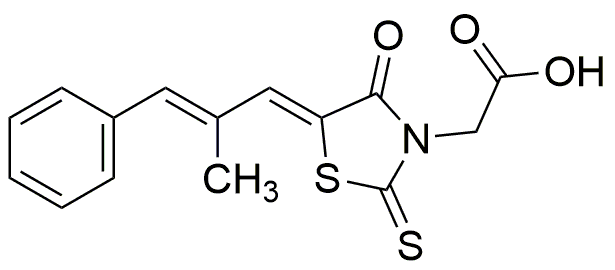Epalrestat is widely utilized in research focused on:
- Diabetes Management: Epalrestat is primarily used in the treatment of diabetic neuropathy, helping to alleviate nerve pain and improve quality of life for patients with diabetes.
- Neuroprotective Research: Researchers are exploring its potential neuroprotective effects, which could lead to advancements in therapies for neurodegenerative diseases.
- Pharmaceutical Development: Epalrestat serves as a valuable compound in the development of new medications aimed at managing complications associated with diabetes, providing a foundation for innovative drug formulations.
- Clinical Trials: It is commonly included in clinical trials to assess its efficacy and safety, contributing to evidence-based practices in diabetes care.
- Comparative Studies: Epalrestat is often used in comparative studies against other treatments for diabetic complications, helping to identify the most effective therapeutic options.
General Information
Properties
Safety and Regulations
Applications
Epalrestat is widely utilized in research focused on:
- Diabetes Management: Epalrestat is primarily used in the treatment of diabetic neuropathy, helping to alleviate nerve pain and improve quality of life for patients with diabetes.
- Neuroprotective Research: Researchers are exploring its potential neuroprotective effects, which could lead to advancements in therapies for neurodegenerative diseases.
- Pharmaceutical Development: Epalrestat serves as a valuable compound in the development of new medications aimed at managing complications associated with diabetes, providing a foundation for innovative drug formulations.
- Clinical Trials: It is commonly included in clinical trials to assess its efficacy and safety, contributing to evidence-based practices in diabetes care.
- Comparative Studies: Epalrestat is often used in comparative studies against other treatments for diabetic complications, helping to identify the most effective therapeutic options.
Documents
Safety Data Sheets (SDS)
The SDS provides comprehensive safety information on handling, storage, and disposal of the product.
Product Specification (PS)
The PS provides a comprehensive breakdown of the product’s properties, including chemical composition, physical state, purity, and storage requirements. It also details acceptable quality ranges and the product's intended applications.
Certificates of Analysis (COA)
Search for Certificates of Analysis (COA) by entering the products Lot Number. Lot and Batch Numbers can be found on a product’s label following the words ‘Lot’ or ‘Batch’.
*Catalog Number
*Lot Number
Certificates Of Origin (COO)
This COO confirms the country where the product was manufactured, and also details the materials and components used in it and whether it is derived from natural, synthetic, or other specific sources. This certificate may be required for customs, trade, and regulatory compliance.
*Catalog Number
*Lot Number
Safety Data Sheets (SDS)
The SDS provides comprehensive safety information on handling, storage, and disposal of the product.
DownloadProduct Specification (PS)
The PS provides a comprehensive breakdown of the product’s properties, including chemical composition, physical state, purity, and storage requirements. It also details acceptable quality ranges and the product's intended applications.
DownloadCertificates of Analysis (COA)
Search for Certificates of Analysis (COA) by entering the products Lot Number. Lot and Batch Numbers can be found on a product’s label following the words ‘Lot’ or ‘Batch’.
*Catalog Number
*Lot Number
Certificates Of Origin (COO)
This COO confirms the country where the product was manufactured, and also details the materials and components used in it and whether it is derived from natural, synthetic, or other specific sources. This certificate may be required for customs, trade, and regulatory compliance.

